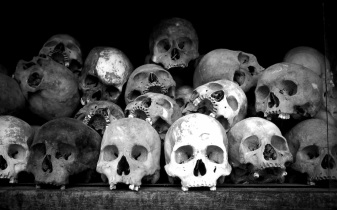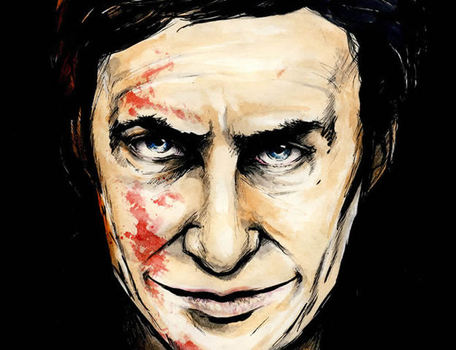Ted Bundy & The Hunt For The Devil
As the body count mounted, the police and the FBI became desperate. They needed an expert, someone with the insight of a serial killer. Not the usual profiler working off of a predictable template, but the real thing. More than four dozen women had been found floating in the Green River and there wasn’t a hint about the killer's real identity. One of the FBI agents said, “What about Bundy? He might help.” The Bundy in question was Ted Bundy, one of the most prolific serial murderers in American history—a charming, educated sociopath of the first order, with a need to talk, and a yearning for the spotlight. He was viewed by the media as a commodity, the poster boy for serial murder. Like most monsters, he was a cypher, but unlike most monsters he had great public relations. The media had created a cottage industry around him, feeding the public selected images to help build his mystique.
Bundy reluctantly agreed to help, but he would only offer hypothetical scenarios. To do more would be incriminating—and with a few appeals left on his death sentence, he had no desire to show his hand.
The image of Bundy that was generally offered to the public was one of a handsome, charming killer. He was ready made for the masses of enabling women who viewed him as misguided, but a potentially redeemable boyfriend archetype—and for others, as a study of the worst instincts of the male psyche, unhinged from any sense of moral accountability. He didn't look, speak or act like a serial killer, whatever that might be, making it easy to relate to Bundy’s hollow vision of a human being. Bundy, the approachable psychopath, was like pornography or art, in reality no one was sure how to define what he was, but they were certain that, if he was really the monster that he was alleged to be, they would somehow know it.
Bundy’s method of talking about the motivation behind psycho-sexual homicide was to do so in the third person to the few people he’d forged a relationship with. A handful of police officers and profilers had spent years, carefully forging a bond of trust with him. They would ask questions and Bundy would shift into performance mode, speaking with the care of a psychologist, offering insights into the most depraved behavior imaginable, all spoken about with an air of objective authority. Bundy acted as a dispassionate observer, one who could express his inner motives and thought processes while keeping a distance between him and the atrocities that were at the heart of his nature.
He gave the police what they needed by telling them how the Green River Killer would inevitably be compelled to revisit the crime scene and relive the thrill of the hunt—and the kill. In doing so he revealed his own compulsions, including torture, dismemberment and necrophilia. Bundy, it turns out, wasn't Bluebeard, he was a ghoul, with a carefully constructed façade of humanity, and nothing more.
Bundy reluctantly agreed to help, but he would only offer hypothetical scenarios. To do more would be incriminating—and with a few appeals left on his death sentence, he had no desire to show his hand.
The image of Bundy that was generally offered to the public was one of a handsome, charming killer. He was ready made for the masses of enabling women who viewed him as misguided, but a potentially redeemable boyfriend archetype—and for others, as a study of the worst instincts of the male psyche, unhinged from any sense of moral accountability. He didn't look, speak or act like a serial killer, whatever that might be, making it easy to relate to Bundy’s hollow vision of a human being. Bundy, the approachable psychopath, was like pornography or art, in reality no one was sure how to define what he was, but they were certain that, if he was really the monster that he was alleged to be, they would somehow know it.
Bundy’s method of talking about the motivation behind psycho-sexual homicide was to do so in the third person to the few people he’d forged a relationship with. A handful of police officers and profilers had spent years, carefully forging a bond of trust with him. They would ask questions and Bundy would shift into performance mode, speaking with the care of a psychologist, offering insights into the most depraved behavior imaginable, all spoken about with an air of objective authority. Bundy acted as a dispassionate observer, one who could express his inner motives and thought processes while keeping a distance between him and the atrocities that were at the heart of his nature.
He gave the police what they needed by telling them how the Green River Killer would inevitably be compelled to revisit the crime scene and relive the thrill of the hunt—and the kill. In doing so he revealed his own compulsions, including torture, dismemberment and necrophilia. Bundy, it turns out, wasn't Bluebeard, he was a ghoul, with a carefully constructed façade of humanity, and nothing more.

In the last few days of his life he gave an interview to James Dobson, a Christian psychologist and broadcaster with a global ministry to families. Bundy spoke about the influence of pornography, especially violent pornography as a catalyst for his deadly dysfunction, a message that reaffirmed the moralist perspective of Dobson’s ministry. He pleaded for his life, suggesting that he wasn't a monster, and that killing him would serve no greater good. Bundy, like all people had the ability to judge his own behavior on a sliding scale. At one end sits the nuclear family, father, mother and children living in harmonious cohabitation as the model of the American norm. At the other end was Hitler, Stalin, Pol Pot and maybe a few American presidents, the fathers of African slavery and Native American genocide. Compared to that standard Bundy was barely a drop of water in an ocean of homicidal impulses. The term monster had carefully been redefined according to his particular psychological needs. He could, according to Dobson, ask for forgiveness, and in God’s great grace be pardoned for his sins, if not in this life, certainly in the next. The idea of justification, like the term monster, had been re-imagined to allow him to enter into the human family, maybe at the dark end, but ingratiated nonetheless. And, with at least one good deed to his credit, maybe a very big God could muster forgiveness, but it seemed unlikely.
As the Green River Killer’s death toll mounted and the mystery deepened, the hunt became a kind of serialized murder-drama. The public appetite for the deranged behavior of a high-level sociopath fired speculation, churning media activity to a fever pitch. When he was finally captured and revealed to be a husband with a mundane job, driving a truck, everyone sighed with relief, trying hard to imagine what drove such a vapid man, a disgruntled nobody. How could a monster live in full view, hosting a malevolent streak that ran so deep and not be detected—not even by those closest to him?
It’s safe to say that monsters are seldom ever so transparent as to be observed without their masks. And possibly, in some very small way, Ted Bundy was right. The monster is only revealed at the end, when their crimes have come to light. Until then they remain concealed, hidden beneath carefully practiced behavior, standing at our side.
Mark Magula
As the Green River Killer’s death toll mounted and the mystery deepened, the hunt became a kind of serialized murder-drama. The public appetite for the deranged behavior of a high-level sociopath fired speculation, churning media activity to a fever pitch. When he was finally captured and revealed to be a husband with a mundane job, driving a truck, everyone sighed with relief, trying hard to imagine what drove such a vapid man, a disgruntled nobody. How could a monster live in full view, hosting a malevolent streak that ran so deep and not be detected—not even by those closest to him?
It’s safe to say that monsters are seldom ever so transparent as to be observed without their masks. And possibly, in some very small way, Ted Bundy was right. The monster is only revealed at the end, when their crimes have come to light. Until then they remain concealed, hidden beneath carefully practiced behavior, standing at our side.
Mark Magula
Click to set custom HTML
